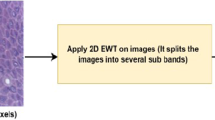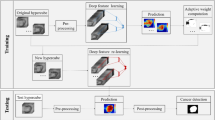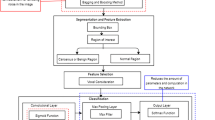Abstract
Purpose
Oral cancer is a complex wide spread cancer, which has high severity. Using advanced technology and deep learning algorithm early detection and classification are made possible. Medical imaging technique, computer-aided diagnosis and detection can make potential changes in cancer treatment. In this research work, we have developed a deep learning algorithm for automated, computer-aided oral cancer detecting system by investigating patient hyperspectral images.
Methods
To validate the proposed regression-based partitioned deep learning algorithm, we compare the performance with other techniques by its classification accuracy, specificity, and sensitivity. For the accurate medical image classification objective, we demonstrate a new structure of partitioned deep Convolution Neural Network (CNN) with two partitioned layers for labeling and classify by labeling region of interest in multidimensional hyperspectral image.
Results
The performance of the partitioned deep CNN was verified by classification accuracy. We have obtained classification accuracy of 91.4% with sensitivity 0.94 and a specificity of 0.91 for 100 image data sets training for task classification of cancerous tumor with benign and for task classification of cancerous tumor with normal tissue accuracy of 94.5% for 500 training patterns was obtained.
Conclusions
We compared the obtained results from another traditional medical image classification algorithm. From the obtained result, we identify that the quality of diagnosis is increased by proposed regression-based partitioned CNN learning algorithm for a complex medical image of oral cancer diagnosis.






Similar content being viewed by others
References
Baljit Singh K, Singh AP, P (2016) Classification of clustered microcalcifications using MLFFBP-ANN and SVM. Egyptian Infor J 17(1):11–20
Bradley J, Erickson MD, Panagiotis K et al (2018) Deep learning in radiology: does one size fit all? J Am Coll Rad 15(3):521–526
Christodoulidis S, Anthimopoulos M, Ebner L et al (2017) Multisource transfer learning with convolutional neural networks for lung pattern analysis. IEEE J Biomed Health Inf 21(1):76–84
Chudgar AV, Conant EF, Weinstein SP (2017) Assessment of disease extent on contrast-enhanced MRI in breast cancer detected at digital breast tomosynthesis versus digital mammography alone. Clin Radiol 72(7):573–579
Deepak Kumar J, Surendra Bilouhan D, Kumar RC (2018) An approach for hyperspectral image classification by optimizing SVM using self-organizing map. J Comput Sci 25(1):252–259
Dey D, Chatterjee B, Dalai S, Munshi S, Chakravorti S (2017) A deep learning framework using convolution neural network for classification of impulse fault patterns in transformers with increased accuracy. IEEE Trans Dielectr Electr Insul 24(6):3894–3897
Dou Q, Chen H, Yu L et al (2016) Automatic detection of cerebral microbleeds from MR images via 3D convolutional neural networks. IEEE Trans Med Imaging 35(5):1182–1195. https://doi.org/10.1109/TMI.2016.2528129
Ge H, Wang L, Liu Y, Li C (2018) Hyperspectral image classification based on adaptive-weighted LLE and clustering-based FSVMs. IET Image Proc 12(6):941–947
Gregory P, Way VF, Sanchez K La (2018) Machine learning detects pan-cancer ras pathway activation in the cancer genome Atlas. Cell Reports 23(1):172–180
He H, Ma Y (2012) Imbalanced learning: foundations, algorithms and applications, 1st edn. Wiley, New York
Heba M, El-Dahshan ESA, El-Horbaty ESM, Abdel-Badeeh M (2018) Classification using deep learning neural networks for brain tumors. Future Comput Inf J 3(1):68–71
Hijazi H, Chan C (2012) A classification framework applied to cancer gene expression profiles. J Healthc Eng 4(4):255–284
Hinton G, Deng L, Yu D et al (2012) Deep neural networks for acoustic modeling in speech recognition: the shared views of four research groups. IEEE Signal Process Mag 29(6):82–97
Huang W, Xiao L, Wei Z et al (2015) A new pan-sharpening method with deep neural networks. IEEE Geosci Remote Sens Lett 12(5):1037–1041
Jie Z, Shufang W, Xizhao W, Guoqing Y, Liyan M (2018) Multi-image matching for object recognition. IET Compt Vis 12(3):350–356
Jin KH, McCann MT, Froustey E et al (2017) Deep convolutional neural network for inverse problems in imaging. IEEE Trans Image Process 26(9):4509–4522
Kalantari N, Ramamoorthi R (2017) Deep high dynamic range imaging of dynamic scenes. ACM Trans Graph 36(4):1–12
Kiranyaz S, Ince T, Gabbouj M (2016) Real-time patient-specific ECG classification by 1-D convolutional neural networks. IEEE Trans Biomed Eng 63(3):664–675
Kourou K, Exarchos TP, Exarchos KP et al (2015) Machine learning applications in cancer prognosis and prediction. Comput Struct Biotech J 13(1):8–17
Lustberg T, van Soest J, Mark G et al (2018) Clinical evaluation of atlas and deep learning based automatic contouring for lung cancer. Radio Onco 126:312–317
Mathews SM, Kambhamettu C, Barner KE (2018) A novel application of deep learning for single-lead ECG classification. Comput Biol Med 99(1):53–62
Murray G, Rourke CO, Hogan J, Fenton FE (2016) Detecting internet search activity for mouth cancer in Ireland. British J of Oral Maxillofacial Surg 54(2):163–165
Ordonez FJ, Roggen D (2016) Deep convolutional and LSTM recurrent neural networks for multimodal wearable activity recognition. Sensors 16(1):1–25
Palsson F, Sveinsson J, Ulfarsson M (2017) Multispectral and hyperspectral image fusion using a 3-d-convolutional neural network. IEEE Geosci Remote Sens Lett 14(5):639–643
Philippe M, Vincent N, Christophe M, Alex L (2018) Survey on deep learning for radiotherapy. Compt Biol Med 98:126–146
Prochzazka A, Vaseghi S, Charvatova H et al (2017) Cycling segments multimodal analysis and classification using neural networks. Appl Sci 7(6):581–591
Wang C, Gong L, Yu Q et al (2017) DLAU: a scalable deep learning accelerator unit on FPGA. IEEE Trans Comput Aided Des Integr Circuits Syst 36(3):513–517
Yuan Y, Lin J, Wang Q (2015) Hyperspectral image classification via multitask joint sparse representation and stepwise MRF optimization. IEEE Trans Cybern 46(12):2966–2977
Zhihuai X, Zhenhua G, Chengshan Q (2018) Palmprint gender classification by convolutional neural network. IET Compt Vis 12(4):476–483
Acknowledgements
The authors would like to thank the Department of Electrical Engineering, Indian Institute of Technology, Delhi and the Management, Principal of Mepco Schlenk Engineering College, Sivakasi for providing us the state-of-art facilities to carry out this research work.
Author information
Authors and Affiliations
Corresponding author
Ethics declarations
Conflict of interest
The authors confirm that they have no conflict of interest regarding this research article.
Rights and permissions
About this article
Cite this article
Jeyaraj, P.R., Samuel Nadar, E.R. Computer-assisted medical image classification for early diagnosis of oral cancer employing deep learning algorithm. J Cancer Res Clin Oncol 145, 829–837 (2019). https://doi.org/10.1007/s00432-018-02834-7
Received:
Accepted:
Published:
Issue Date:
DOI: https://doi.org/10.1007/s00432-018-02834-7




